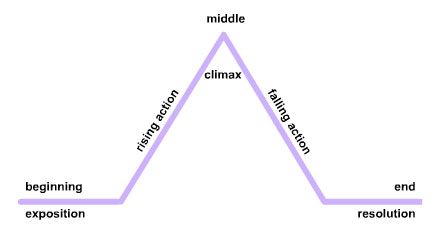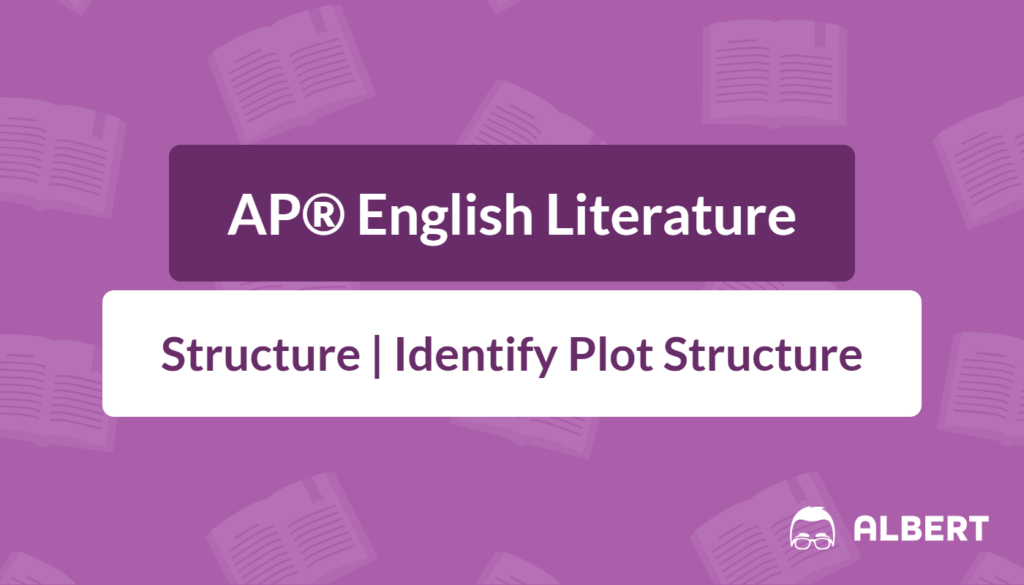Plot structure lies at the heart of every story. For those preparing for the AP® English Literature exam, understanding how plot orders events in a narrative is crucial. This overview explores what plot structure is, why it matters, and how to break it down step by step. By recognizing the building blocks of plot development, readers can analyze literature in ways that reveal deeper themes and character motivations. The following guide also demonstrates how authors choose various plot structures—linear, non-linear, or circular—to shape a reader’s experience. Examining these patterns can lead to more insightful essays and stronger literary discussions.
What We Review
What Is Plot Structure?
Plot structure refers to how events are arranged in a story. Typically, authors often follow a progression from an introduction of characters and setting to a final resolution of the central conflict. However, plot structure is not always linear. Some authors rearrange events to show flashes of the past, dreams of the future, or multiple narrative viewpoints. By studying plot structure, readers gain a clearer sense of how an author deliberately organizes events to shape meaning.
Recognizing how the plot is constructed is essential for AP® Literature students because it helps uncover the story’s core themes. A well-structured plot can illuminate relationships among characters and highlight the tension that drives the narrative. As a result, understanding plot structure supports a more focused analysis, whether one is reading a short piece of fiction, a novel, or a drama.
The Five Key Elements of Plot Structure
Most stories contain five essential parts: Exposition, Rising Action, Climax, Falling Action, and Resolution. Each of these plays a critical role in developing the narrative and guiding readers through the text.

Exposition
The exposition introduces the setting, characters, and central conflict. This groundwork helps readers understand the background before the main action begins.
Consider F. Scott Fitzgerald’s The Great Gatsby. At the beginning of the novel, Nick Carraway describes the glittering world of West Egg and East Egg. Notice how Fitzgerald provides context about wealth, location, and social dynamics through Nick’s observations. When Nick says, “I lived at West Egg, the—well, the less fashionable of the two,” he is setting up the social hierarchy that underpins the story.
- Focus first on the setting: identify where and when the events unfold.
- Then, observe how conflict arises: the mention of Gatsby’s mansion across the bay signals intrigue and social tension.
- Also, note any key background details: Nick’s status as an outsider shapes his perspective on the characters.
Rising Action
The rising action develops the central conflict by introducing complications and escalating tension. This stage keeps readers engaged by revealing new challenges or layers to the story’s conflict.
Take, for instance, Mary Shelley’s Frankenstein, Victor’s initial experiments, his creation of the Creature, and the subsequent fear he feels all build anticipation. Victor describes his horror at success: “I beheld the wretch—the miserable monster whom I had created.” This line signals the growing conflict between creator and creation.
- Track how challenges accumulate: Victor’s guilt increases conflict with the Creature and also within himself.
- Identify moments that intensify the story’s stakes: the Creature’s need for understanding contrasts with Victor’s terror.
- Observe how tension moves the plot forward: every new complication heightens the drama.
Climax
The climax is the story’s turning point—the moment of highest tension. The main character often faces a critical challenge or decision that affects the outcome.
A powerful example appears in William Shakespeare’s Hamlet. The title character’s confrontation with his mother in Act III, Scene IV, triggers a cascade of disastrous events. When Hamlet stabs Polonius behind the curtain, he irrevocably changes the course of the play.
- Recognize how everything builds to this peak: earlier revelations about King Hamlet’s murder heighten the pressure on Prince Hamlet.
- Look for dramatic confrontations: Shakespeare places key confrontations in enclosed spaces (like Gertrude’s chamber) to intensify emotional strain.
- Consider how this moment portends consequences: after Polonius’s death, there is no turning back from the tragedy.
Falling Action
The falling action shows the fallout of the climax and begins steering the story toward its conclusion. Characters deal with the results of the crucial turning point.
For example, in Toni Morrison’s Beloved, the aftermath of Sethe’s desperate choice reveals lingering trauma. The ghostly presence in Sethe’s home demonstrates how past actions create ripples in the present.
- Notice how conflicts begin to resolve or transform: Sethe must confront the tangible haunting that stems from her prior decisions.
- Observe how tension slowly unravels: old wounds force characters to either reconcile or succumb to despair.
- Connect the falling action to the novel’s broader themes: Morrison emphasizes how history’s weight continues to affect individual lives.
Resolution (Denouement)
The resolution ties up loose ends or, in some cases, leaves the reader with an open-ended conclusion. Often, it reflects on the story’s overarching theme or reveals the final state of the characters.
Zora Neale Hurston’s Their Eyes Were Watching God concludes with Janie reflecting on her journey. After her tumultuous relationships and the loss of Tea Cake, she understands her own strength: “She pulled in her horizon like a great fish-net.” This brief image represents her hard-won self-awareness.
- Identify how the main conflict is resolved or reframed: Janie survives personal losses and emerges with clarity.
- Note any open questions: the ending may still leave some ideas unresolved.
- Reflect on the larger message: Hurston suggests that true fulfillment often involves self-discovery through struggle.
Different Types of Plot Structures
There are multiple ways to arrange these five elements. Some narratives are straightforward, while others circle back or jump in time. Each approach influences how readers experience the story.
Linear Plot Structure
A linear plot follows a straight line from beginning to end. Events are presented in chronological order, so readers progress through exposition, rising action, climax, falling action, and resolution without major flashbacks or disruptions.
Stories like Kate Chopin’s The Awakening largely move forward in time. Edna Pontellier’s growing dissatisfaction with her traditional life unfolds step by step, drawing readers gradually toward her pivotal choices.
Non-Linear Plot Structure
A non-linear plot arranges events out of chronological order. Authors may include flashbacks, flashforwards, or shifts in perspective to gradually uncover hidden details.
Tim O’Brien’s collection of linked stories, The Things They Carried, jumps around in time to show how memories of the Vietnam War overlap. This structure mirrors the fragmented nature of recollection, as O’Brien reveals truths about trauma, friendship, and grief in a patchwork form.
Circular Plot Structure
A circular plot begins and ends in the same or a similar place, linking the final scene back to the initial introduction. This design can highlight a character’s transformation or underscore a cyclical theme.
Some classic myths follow this pattern, where a hero leaves home and returns fundamentally changed. By concluding with a parallel to the beginning, the story underscores how experiences have reshaped the character’s view of the world.
How Plot Structure Affects Character Development
Plot and character are deeply intertwined. As characters move through each plot stage, they face challenges that reveal their personalities, values, and flaws. Their decisions at pivotal moments forge the path forward and reflect the story’s themes. In a non-linear story, back-and-forth shifts can illuminate how past choices continue to shape present behavior. In a circular plot, returning to the outset highlights personal growth or continued struggle.
For instance, in The Awakening, Edna’s journey from a dutiful wife to someone seeking independence drives the story’s central conflict. The linear unfolding allows each small decision to build upon the last. Meanwhile, her transformation is tied closely to the progression of events, revealing how plot structure directly influences character arcs.
Analyzing Plot Structure in Literature
A straightforward strategy helps when analyzing the plot of any text:
- Read carefully for context: Identify where each phase (exposition, rising action, climax, falling action, resolution) starts and ends.
- Mark key events: Look for turning points, such as surprising conflicts or major decisions.
- Examine shifts in tone or setting: These often signal movement from one plot element to the next.
- Reflect on how each part connects: Notice how the buildup of tension eventually releases at the climax, then moves toward closure.
Understanding plot structure highlights how authors carefully shape a reader’s emotional journey. This approach can also clarify the underlying messages or themes that the story conveys.
Practical Application: Identifying Plot Structure in “Romeo and Juliet”
William Shakespeare’s Romeo and Juliet offers a classic example of dramatic structure. Readers can spot all five elements clearly:
- Exposition: The play opens with the feud between the Montagues and Capulets. This establishes the long-standing rivalry affecting Romeo and Juliet’s forbidden love.
- Rising Action: Romeo and Juliet meet at the Capulet party, prompting a series of secret plans, such as their hurried marriage. Tension grows each time they risk discovery.
- Climax: The climax occurs when Romeo, reacting to Mercutio’s death, slays Tybalt. This event forces Romeo into exile and sets off the tragic final act.
- Falling Action: Juliet becomes desperate, enlisting Friar Lawrence’s help. Their plan to reunite fails due to miscommunication.
- Resolution: Both lovers die, uniting the feuding families through shared grief.
By tracking these plot points, students see how Shakespeare uses dramatic timing to build longing, conflict, and ultimately tragedy. Observing how these events align with the five-part structure makes it easier to discuss themes of fate, love, and family honor.
Quick Reference Chart: Key Terms and Definitions
| Term | Definition |
| Plot Structure | The deliberate arrangement of events in a story, including exposition, rising action, climax, falling action, and resolution. |
| Exposition | The introduction where characters, setting, and main conflict are established. |
| Rising Action | Events that build tension, expand conflicts, and heighten stakes leading to the climax. |
| Climax | The peak of the story’s tension where the main conflict reaches a turning point. |
| Falling Action | Events following the climax that reduce tension and guide the story toward its conclusion. |
| Resolution (Denouement) | The final unraveling of the plot, tying up loose ends or showing how conflicts are resolved. |
| Linear Plot | A straightforward chronology where events occur in time order from start to finish. |
| Non-Linear Plot | A narrative that jumps in time, often using flashbacks or multiple perspectives. |
| Circular Plot | A structure that begins and ends in a similar situation, emphasizing cycles or transformations. |
Recognizing these terms provides a strong foundation for analyzing plot structure in various genres, including short fiction, longer novels, and plays.
A clear grasp of plot structure gives readers a window into how authors shape meaning and emotion. By paying close attention to each phase—exposition, rising action, climax, falling action, and resolution—students can form richer interpretations of both classic and modern works. This awareness is valuable for navigating the AP® Literature exam, where well-founded analysis and textual evidence are essential for success. Understanding these elements consistently unlocks deeper insight into character development and theme, ensuring a more rewarding literature experience.
Sharpen Your Skills for AP® English Literature and Composition
Are you preparing for the AP® English Literature and Composition test? We’ve got you covered! Try our review articles designed to help you confidently tackle real-world AP® English Literature and Composition problems. You’ll find everything you need to succeed, from quick tips to detailed strategies. Start exploring now!
- AP® English Literature: Sequence of Events
- AP® English Literature: Analyzing Structure
- AP® English Literature: Contrasts in Structure
- AP® English Literature: How Plot Events Shape Meaning
- AP® English Literature: Conflict in a Story
Need help preparing for your AP® English Literature and Composition exam?
Albert has hundreds of AP® English Literature and Composition practice questions, free response, and full-length practice tests to try out.








